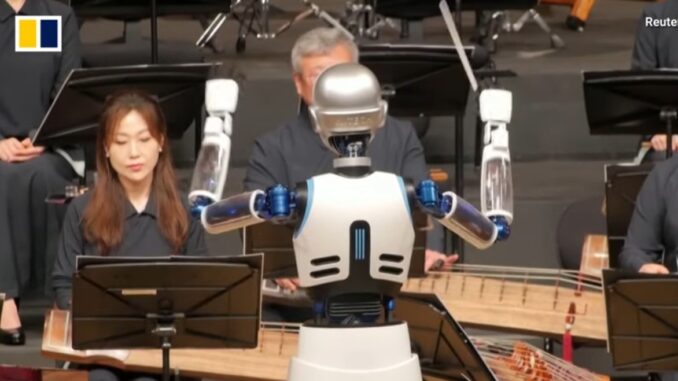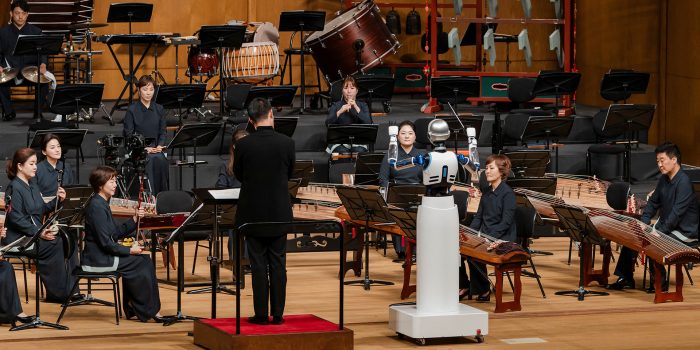In a groundbreaking event that left music enthusiasts and experts astounded, a remarkable development took place at the National Theater of Korea in Seoul. The conductor’s podium was graced not by a human maestro, but by an extraordinary creation: a robot named EveR 6.
This momentous occasion marked the first time a robot led an ensemble of 60 musicians, who played traditional Korean instruments, in front of a live audience of 950 people.
EveR 6, a creation of the Korea Institute of Industrial Technology (KITECH), stood tall at a height of five feet (1.8 meters). With its robotic arms dynamically wielding a baton and its head gracefully making subtle gestures, the robot emulated the motions and presence of a human conductor.
The performance showcased its ability to direct the musicians, just like a maestro would, bringing harmony and rhythm to the music.
%2F2023%2F07%2F03%2Fimage%2Fjpeg%2FvZCNVdOw3GQSowVCxk1EirsOTPtoNUEifvqCW7Bc.jpg&w=1080&q=75)
Lee Dong-Wook, a member of the team at KITECH responsible for developing EveR 6, clarified that the robot is not a generative artificial intelligence like ChatGPT.
“EveR 6 is a robot that executes programmed movements,” said Lee. “The robot is programmed using the ‘motion capture’ technology of digitally recording a person’s baton trajectory through sensor attachments.”
However, he revealed that there are plans to integrate artificial intelligence into the robot, envisioning a future where it can serve as an auxiliary tool for conductors, responding to their specific beat requests.
During the evening’s program, the robot-led ensemble performed three out of the five musical pieces. One of the performances was a joint effort, with Korean conductor Choi Soo-yeoul collaborating alongside the robot.
However, despite the technological marvel on display, Sixty-two-year-old audience member Song In-ho felt that the robot’s conducting skills were at an elementary level, suggesting that there is still progress to be made in refining its abilities.
“I guess it would be able to do the conducting all by itself when it’s equipped with artificial intelligence to understand and analyze the music,” Song added.
Kim Ji-Min, a music student who had come to see the robot’s performance, told AFP, “I came here worried whether this robot could pull this off without a glitch. But I found it to be in great harmony with the musicians. It seemed like a worthwhile challenge and it felt like a whole new world for me.”

While the notion of robots replacing humans in various domains often sparks debates, it is worth noting that EveR 6 is not the first humanoid robot to take center stage as a conductor. As early as 2008, Honda’s robot Asimo conducted an orchestra, followed by YuMi, a dual-arm robot that led a classical orchestra in Switzerland in 2017.
In subsequent years, the second-generation AI robot Alter 2 was conducted in Japan in 2018, and Alter 3, a third-generation robot, took on conducting duties in 2020.
This recent event, therefore, adds to the growing list of remarkable achievements where technology and art intersect. While the question of robots replacing human conductors lingers, these performances serve as a testament to the advancements in robotics and artificial intelligence, pushing the boundaries of what machines can accomplish in the realm of music and performance.


